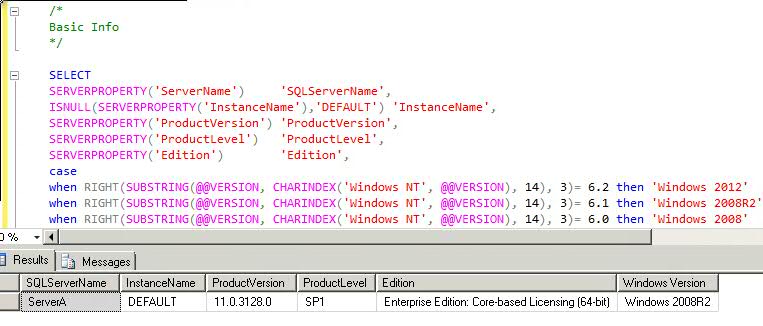Very simple script that list the total size of a database and its transaction log.
If you need for SQL 2000 click here
/*
DESCRIPTION List space used on databases
CONFIGURATION none
Compatibility list:
MSSQL2012
MSSQL2008
MSSQL2005
DOES NOT WORK
MSSQL2000
*/
SELECT
SERVERPROPERTY('SERVERNAME') ServerName,
SERVERPROPERTY('IsClustered') IsCluster,
SERVERPROPERTY('ProductVersion') AS ProductVersion,
case
when RIGHT(SUBSTRING(@@VERSION, CHARINDEX('Windows NT', @@VERSION), 14), 3)= 6.3 then 'Windows 2012R2'
when RIGHT(SUBSTRING(@@VERSION, CHARINDEX('Windows NT', @@VERSION), 14), 3)= 6.2 then 'Windows 2012'
when RIGHT(SUBSTRING(@@VERSION, CHARINDEX('Windows NT', @@VERSION), 14), 3)= 6.1 then 'Windows 2008R2'
when RIGHT(SUBSTRING(@@VERSION, CHARINDEX('Windows NT', @@VERSION), 14), 3)= 6.0 then 'Windows 2008'
when RIGHT(SUBSTRING(@@VERSION, CHARINDEX('Windows NT', @@VERSION), 14), 3)= 5.2 then 'Windows 2003'
when RIGHT(SUBSTRING(@@VERSION, CHARINDEX('Windows NT', @@VERSION), 14), 3)= 5.1 then 'Windows XP'
when RIGHT(SUBSTRING(@@VERSION, CHARINDEX('Windows NT', @@VERSION), 14), 3)= 5.0 then 'Windows 2000'
else RIGHT(SUBSTRING(@@VERSION, CHARINDEX('Windows NT', @@VERSION), 14), 3)
end,
DB_NAME(db.database_id) DatabaseName,
(CAST(mfrows.RowSize AS FLOAT)*8)/1024 RowSizeMB,
(CAST(mflog.LogSize AS FLOAT)*8)/1024 LogSizeMB
FROM sys.databases db
LEFT JOIN (
SELECT database_id, SUM(size) RowSize
FROM sys.master_files
WHERE type = 0
GROUP BY database_id, type
) mfrows ON mfrows.database_id = db.database_id
LEFT JOIN (
SELECT database_id, SUM(size) LogSize
FROM sys.master_files
WHERE type = 1
GROUP BY database_id, type
) mflog ON mflog.database_id = db.database_id
WHERE
db.database_id > 4
For SQL 2000
/*
DESCRIPTION List space used on databases
CONFIGURATION none
Compatibility list:
MSSQL2000
*/
SELECT
SERVERPROPERTY('SERVERNAME') ServerName,
SERVERPROPERTY('IsClustered') IsCluster,
SERVERPROPERTY('ProductVersion') AS ProductVersion,
case
when RIGHT(SUBSTRING(@@VERSION, CHARINDEX('Windows NT', @@VERSION), 14), 3)= 6.3 then 'Windows 2012R2'
when RIGHT(SUBSTRING(@@VERSION, CHARINDEX('Windows NT', @@VERSION), 14), 3)= 6.2 then 'Windows 2012'
when RIGHT(SUBSTRING(@@VERSION, CHARINDEX('Windows NT', @@VERSION), 14), 3)= 6.1 then 'Windows 2008R2'
when RIGHT(SUBSTRING(@@VERSION, CHARINDEX('Windows NT', @@VERSION), 14), 3)= 6.0 then 'Windows 2008'
when RIGHT(SUBSTRING(@@VERSION, CHARINDEX('Windows NT', @@VERSION), 14), 3)= 5.2 then 'Windows 2003'
when RIGHT(SUBSTRING(@@VERSION, CHARINDEX('Windows NT', @@VERSION), 14), 3)= 5.1 then 'Windows XP'
when RIGHT(SUBSTRING(@@VERSION, CHARINDEX('Windows NT', @@VERSION), 14), 3)= 5.0 then 'Windows 2000'
else RIGHT(SUBSTRING(@@VERSION, CHARINDEX('Windows NT', @@VERSION), 14), 3)
end,
DB_NAME(db.dbid) DatabaseName,
(CAST(mfrows.RowSize AS FLOAT)*8)/1024 RowSizeMB,
(CAST(mflog.LogSize AS FLOAT)*8)/1024 LogSizeMB
FROM sysdatabases db
LEFT JOIN (
SELECT dbid, SUM(size) RowSize
FROM master..sysaltfiles
WHERE groupID = 1
GROUP BY dbid, groupID
) mfrows ON mfrows.dbid = db.dbid
LEFT JOIN (
SELECT dbid, SUM(size) LogSize
FROM master..sysaltfiles
WHERE groupID <> 1
GROUP BY dbid, groupID
) mflog ON mflog.dbid = db.dbid
WHERE
db.dbid > 4
